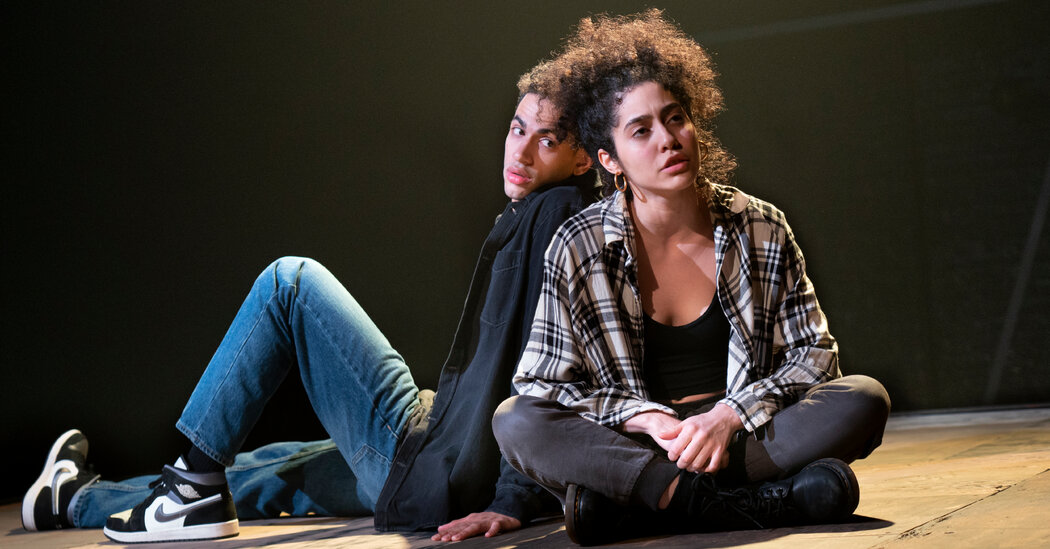
Review: In ‘Sanctuary City,’ Slamming the Door on the Dream
09/21/2021American playwrights typically stake out a territory and stick to it. Tennessee Williams, having adopted that name, became the poet of the ghostly, ghastly South. August Wilson was the bard of striving Black Pittsburgh. Edward Albee lurked like an imp inside the brain (or perhaps the cirrhotic liver) of the warped New England WASP aristocracy.
Add Martyna Majok to the list. Her territory is Newark, but not just the literal one in the shadow of Manhattan. Hers is the dystopia at America’s back door, where stateless people, desperate for even a foothold in the country where they live, find themselves hounded by danger at every turn.
In plays like “queens,” the Pulitzer Prize-winning “Ironbound” and now “Sanctuary City,” which opened on Tuesday at the Lucille Lortel Theater, Majok writes about the plight of undocumented immigrants, with a glowering side-eye cast on the rest of us. Her unsparing, unsentimental vision of America, brought to life in Rebecca Frecknall’s thrillingly minimal production for New York Theater Workshop, is like Albee’s of the country club set in “A Delicate Balance”: friendly to guests in theory, fiercely rejecting in fact.
But “Sanctuary City” focuses on those who want to enter, not those who would turn them away. As if to announce that theme, the play begins, in 2001, with a loud banging on a fourth-floor window, as a high school girl, having climbed a fire escape, seeks refuge in a friend’s apartment. It soon becomes clear that the girl and her mother, both undocumented, are frequently beaten by the mother’s husband; they don’t report the abuse for fear of being deported.
The friend who opens the window is also undocumented, getting by, along with his mother, on under-the-table service jobs that leave them vulnerable to harassment and extortion. Even in a so-called sanctuary city like Newark — in which local authorities limit cooperation with federal immigration enforcement agents — any traffic stop could result in removal.
Still, Newark is their home — or at least it is until the boy, entering his senior year of high school, learns that his mother will soon return to her country of origin. He must quickly decide, after 10 years in New Jersey, whether to accompany her to a place he has good reason to fear or to stay in a place where the fear is certain but is mitigated by friends, dreams and excellent chicken parm.
Neither family’s country of origin is specified; nor are the boy and girl given names. The script simply calls them B and G, as if anything more were a privilege reserved for citizens. Even so, Majok’s masterly portraiture, a magic trick involving only mouthy dialogue and headlong action, reveals them right down to what’s hiding in their youthful, battered hearts.
And love, of course, comes into it, in several varieties. As they try to think past their immediate problems, B (Jasai Chase-Owens) and G (Sharlene Cruz) find common cause in each other. Soon enough, G is spending most nights in B’s bed, chastely but not necessarily unromantically. She is perhaps more offended than relieved by his propriety.
The first half of “Sanctuary City,” about 50 minutes, is written in shards of scenes — some gleeful, some sad, all trenchant — that come flying off the stage in short, jagged bursts of a few seconds each. As in plays like Caryl Churchill’s “Love and Information” and Nick Payne’s “Constellations,” these are often deliberately disorienting, changing subject suddenly and delivered out of order.
But Majok is not using the fracturing of narrative, as Churchill and Payne do, to dramatize quantum possibility. By challenging the audience to assemble the story, she is instead forcing us into her characters’ heads as they piece together their lives under the pressure of constant emergency.
Sometimes this means returning to a fork in the road to cast an old choice in the light of new knowledge. Other times, Majok repeats small whorls of dialogue with slight variations to demonstrate how quickly ad hoc adaptations become rigid patterns. Whenever G has visible bruises, B helps her choose a believable excuse for skipping school: the flu, a cold, chickenpox, another cold. G rejects lice, though; even in deceit there is pride.
Keeping up with these spurts of story also forces you to match and thus become fully invested in the fast-twitch energy and impulsiveness of teenagers. It smartly follows that when B and G eventually face an adult crisis, the play switches gears and slows down.
That crisis comes in the form of an opportunity: G’s mother, we learn, has acquired her naturalization papers, meaning that G can now apply for a scholarship to college. As a citizen, she is also, quite suddenly and powerfully, in a position to help B achieve his own dreams, if only through a plan that may or may not be subterfuge.
As the implications of G’s offer play out over the course of three years, and in particular during a night in December 2006, the second half of “Sanctuary City” becomes a single, long, continuous scene. I won’t say anything further about the story, which snaps with surprises, except that it involves a third character (Austin Smith) and some painful, interlocking choices.
This second half, with its seesawing sequence of arguments, is not as original or convincing as the kaleidoscopic first. (For one thing, it seems overly compacted by the clever structural conceit.) Even so, I have rarely seen a play that so effectively embodies the way external forces — in this case, immigration policies in the United States — distort the inner lives of actual humans. What love is, and can ever mean, is lost in the muddle between the heart and the law.
Though they are in their mid-20s, Chase-Owens and Cruz throw themselves into that muddle with all the incandescence and rage of late adolescence. Also with the pent-up excitement of a production that has had an 18-month intermission, after being shut down by the pandemic a week into previews last year.
Frecknall’s staging — with a huge assist from Isabella Byrd’s lighting and Mikaal Sulaiman’s sound — is just as breakneck, as if it had shed its clothing to run faster through the woods. The pared-down, nonliteral effects produce great laughs but also great emotion, as when B and G sleep standing up, merely repositioning their arms and twisting their torsos to show us how they are turning.
But do not get too attached to their adolescent fumblings. Neither the naïveté that makes G believe she needn’t pack a winter coat for college in Boston because “they give you sweatshirts there,” nor the wary sweetness that causes B to offer her his mother’s abandoned clothing as long as she doesn’t sell it, can last long in a world that delivers dreams to some so-called Dreamers and just as wantonly crushes others.
And that’s really Majok’s American territory: the place where the airy abstractions of policy play out in the anguish of personality. Newark may be a sanctuary city, but there is no sanctuary to protect you from the necessary betrayals of those you love — including your adopted country.
Sanctuary City
Through Oct. 10 at the Lucille Lortel Theater, Manhattan; nytw.org. Running time: 1 hour 40 minutes.
Source: Read Full Article

